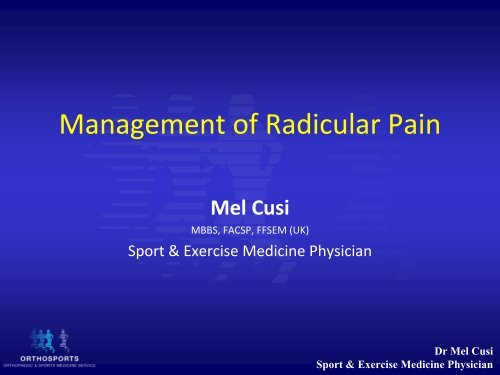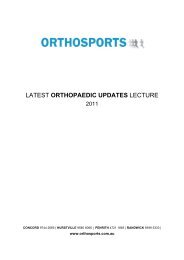Management of Radicular Pain
Management of Radicular Pain
Management of Radicular Pain
You also want an ePaper? Increase the reach of your titles
YUMPU automatically turns print PDFs into web optimized ePapers that Google loves.
<strong>Management</strong> <strong>of</strong> <strong>Radicular</strong><br />
Mel Cusi<br />
MBBS, FACSP, FFSEM (UK)<br />
Sport & Exercise Medicine Physician<br />
<strong>Pain</strong><br />
Dr Mel Cusi<br />
Sport & Exercise Medicine Physician
<strong>Management</strong> <strong>of</strong> <strong>Radicular</strong><br />
A.<br />
B.<br />
C.<br />
D.<br />
Background<br />
Epidemiology<br />
Diagnosis<br />
Treatment<br />
<strong>Pain</strong><br />
Dr Mel Cusi<br />
Sport & Exercise Medicine Physician
•<br />
•<br />
•<br />
A.<br />
Names and concepts<br />
–<br />
–<br />
<strong>Radicular</strong><br />
pain<br />
Radiculopathy<br />
Background<br />
Structures that can produce<br />
radicular Sx<br />
–<br />
–<br />
Sinu‐vertebral nerve<br />
Nerve root<br />
Mechanisms <strong>of</strong> pain<br />
–<br />
–<br />
Direct toxic effect <strong>of</strong> disc material<br />
Chemical substances<br />
Dr Mel Cusi<br />
Sport & Exercise Medicine Physician
•<br />
•<br />
B.<br />
Epidemiology<br />
Occurs in 3‐5% <strong>of</strong> the population<br />
–<br />
–<br />
More frequent in males in their 40’s<br />
More frequent in females in their 50’s<br />
In sporting population<br />
–<br />
–<br />
More frequent in sports that combine spinal<br />
flexion/extension with rotation<br />
Fast bowlers, gymnasts, dancers, RU<br />
backrowers, golfers, weightlifters, baseball<br />
pitchers<br />
Dr Mel Cusi<br />
Sport & Exercise Medicine Physician
•<br />
•<br />
<strong>Radicular</strong><br />
C.<br />
Diagnosis<br />
pain is only a descriptive symptom<br />
Diagnosis is made on the usual basis <strong>of</strong><br />
–<br />
–<br />
–<br />
History<br />
Clinical examination<br />
Appropriate investigations (when required)<br />
Dr Mel Cusi<br />
Sport & Exercise Medicine Physician
•<br />
•<br />
•<br />
History<br />
Acute LBP radiating to buttock / lower limb<br />
Worse with flexion, sneezing, coughing.<br />
Sitting worse than standing<br />
Some pointers<br />
–<br />
–<br />
–<br />
Referred pain from L1‐3 does not reach the<br />
knee<br />
Unusual Symptoms (weight loss, fever, chills)<br />
point to something else<br />
Beware <strong>of</strong> cauda equina: surgical emergency<br />
Dr Mel Cusi<br />
Sport & Exercise Medicine Physician
• Sensation<br />
Neurological Examination<br />
– Subjective<br />
– Objective (light touch, pinprick)<br />
• Dermatomal distribution<br />
is a poor indicator <strong>of</strong> the<br />
level <strong>of</strong> pathology<br />
(Albert et al. 2010)<br />
Dr Mel Cusi<br />
Sport & Exercise Medicine Physician
Neurological Examination<br />
• Power: Identify what levels are deficient<br />
Segmental motor innervation <strong>of</strong> the lower<br />
limb<br />
Dr Mel Cusi<br />
Sport & Exercise Medicine Physician
Neurological Examination<br />
• Reflexes<br />
– Patellar tendon (knee jerk)<br />
• L2/3/4<br />
– Ankle tap (ankle jerk)<br />
• S1<br />
Dr Mel Cusi<br />
Sport & Exercise Medicine Physician
•<br />
•<br />
•<br />
•<br />
•<br />
Diferential<br />
Disc protrusion / extrusion<br />
(nerve root compression)<br />
Hip pathology<br />
(L1‐2 dermatome distribution)<br />
Trochanteric<br />
bursitis<br />
(buttock / thigh pain)<br />
SIJ incompetence<br />
(pseudosciatica)<br />
Facet joint pain<br />
(usually no leg pain)<br />
diagnosis<br />
Dr Mel Cusi<br />
Sport & Exercise Medicine Physician
•<br />
•<br />
•<br />
•<br />
•<br />
Investigations<br />
To confirm or exclude a specific diagnosis<br />
X‐ray: to exclude organic bone pathology<br />
CT scan: good to assess bone and disc<br />
hernias<br />
MRI: best modality to assess s<strong>of</strong>t tissues<br />
Caution: treat the patient, not the picture<br />
35% <strong>of</strong> normal 35 y.o. females show<br />
some form <strong>of</strong> “pathology”<br />
on MRI<br />
Dr Mel Cusi<br />
Sport & Exercise Medicine Physician
Investigations<br />
Dr Mel Cusi<br />
Sport & Exercise Medicine Physician
•<br />
•<br />
Initial<br />
–<br />
–<br />
D.<br />
Non‐operative<br />
Surgical<br />
Treatment<br />
Aspects <strong>of</strong> Rehabilitation and secondary<br />
prevention (<strong>of</strong> recurrences)<br />
Dr Mel Cusi<br />
Sport & Exercise Medicine Physician
•<br />
•<br />
•<br />
•<br />
•<br />
Non operative Treatment<br />
<strong>of</strong> disc herniation<br />
Regular analgesia (not p.r.n)<br />
Anti‐inflammatories<br />
–<br />
–<br />
NSAIDS<br />
Early peri‐radicular<br />
steroid injection?<br />
Maintain physical activity (ADLs<br />
at least)<br />
Extension exercises (if extrusion or<br />
sequestration extension can make pain worse)<br />
For how long???<br />
Dr Mel Cusi<br />
Sport & Exercise Medicine Physician
•<br />
•<br />
Non operative Treatment<br />
<strong>of</strong> disc herniation<br />
As long as there is improvement, continue<br />
non‐operative treatment for up to three<br />
months.<br />
If progress is not adequate patient will tell you<br />
Dr Mel Cusi<br />
Sport & Exercise Medicine Physician
•<br />
•<br />
•<br />
•<br />
•<br />
Surgical Options<br />
(for disc herniation)<br />
Surgical decompression is a QOL decision<br />
Long term results similar to non‐operative<br />
measures<br />
There is a 10% recurrence rate<br />
Discectomy +/‐ laminotomy<br />
<strong>of</strong> the nerve root<br />
+/‐<br />
rhyzolysis<br />
Microdiscectomy does not mean a smaller<br />
incision, but the use <strong>of</strong> vision augmentation<br />
Dr Mel Cusi<br />
Sport & Exercise Medicine Physician
•<br />
•<br />
Aspects <strong>of</strong> Rehabilitation<br />
Make patient self‐sufficient, independent <strong>of</strong><br />
–<br />
–<br />
Medication<br />
Health practitioners<br />
•<br />
(doctors, physios, osteos, chiros, massage Rx, etc)<br />
Prevention <strong>of</strong> recurrences<br />
–<br />
–<br />
–<br />
General fitness<br />
Lumbopelvic<br />
stability training<br />
Manual handling and postural training<br />
Dr Mel Cusi<br />
Sport & Exercise Medicine Physician
THANK YOU<br />
Dr Mel Cusi<br />
Sport & Exercise Medicine Physician




